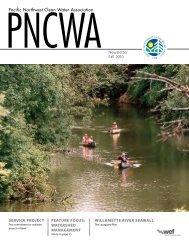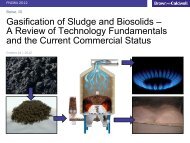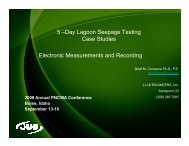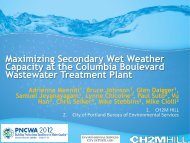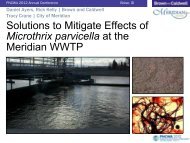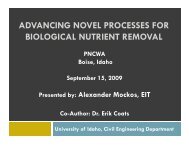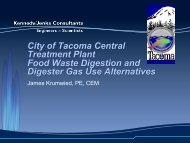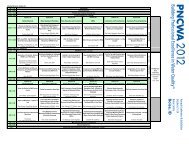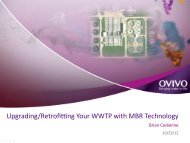Retrofitting an Aeration Basin with Anoxic Zone to Reduce ... - pncwa
Retrofitting an Aeration Basin with Anoxic Zone to Reduce ... - pncwa
Retrofitting an Aeration Basin with Anoxic Zone to Reduce ... - pncwa
Create successful ePaper yourself
Turn your PDF publications into a flip-book with our unique Google optimized e-Paper software.
<strong>Retrofitting</strong> <strong>an</strong> <strong>Aeration</strong> <strong>Basin</strong> <strong>with</strong> <strong>Anoxic</strong> <strong>Zone</strong> <strong>to</strong><br />
<strong>Reduce</strong> Operations Cost <strong>an</strong>d Improve Perform<strong>an</strong>ce<br />
Ed Griffenberg, Operations Specialist<br />
HDR Engineering, Edmonds, WA<br />
2012 PNCWA Conference, Boise, Idaho
Case Study – Mount Vernon WWTP<br />
• Project Background<br />
• Retrofit Ideas<br />
• Model<br />
• Implementation<br />
• Reality Check<br />
• Design & Construction<br />
• Conclusion
Background<br />
• The City of Mount Vernon is located approximately half way between<br />
Everett <strong>an</strong>d Bellingham in Washing<strong>to</strong>n State.<br />
• Largest community in Skagit County.<br />
• Draper Valley Farm is the largest industrial cus<strong>to</strong>mer (15-20% of<br />
loading).
Mount Vernon<br />
Wastewater Treatment Pl<strong>an</strong>t - Before Upgrade
Wastewater Treatment Pl<strong>an</strong>t<br />
• Provides secondary treatment utilizing the activated sludge process.<br />
This process is more flexible th<strong>an</strong> others (trickling filters for example)<br />
in adapting <strong>to</strong> ch<strong>an</strong>ges, such as nutrient removal.<br />
• Originally designed for TSS <strong>an</strong>d BOD removal only<br />
• Beg<strong>an</strong> partial nitrifying in 2001
Why Nitrify?<br />
• Required by new permit<br />
• Difficult <strong>to</strong> avoid in summer<br />
• Develop data for pl<strong>an</strong>t upgrade design<br />
• Opera<strong>to</strong>r interest
Nitrogen Tr<strong>an</strong>sformations<br />
Org<strong>an</strong>ic N<br />
Nitrification<br />
Decomposition<br />
Ammonia<br />
Assimilation<br />
Org<strong>an</strong>ic N<br />
(Cells)<br />
Org<strong>an</strong>ic N<br />
(Growth)<br />
O 2<br />
Nitrite<br />
O 2<br />
Org<strong>an</strong>ic Carbon<br />
Nitrate<br />
Denitrification<br />
Nitrogen Gas
Wastewater Treatment Pl<strong>an</strong>t Capacity<br />
• Average day design flow of 5.6 MGD<br />
• Peak design flow of 12.0 MGD
Future Exp<strong>an</strong>sions<br />
Increase Pl<strong>an</strong>t Capacity from 10.8 MGD <strong>to</strong> 16.4 MGD
<strong>Aeration</strong> <strong>Basin</strong> Influent<br />
Parameter Unit Summer<br />
Flow" MGD" 2.63"<br />
COD" mg/L" 265"<br />
BOD" mg/L" 122"<br />
TSS" mg/L" 75"<br />
TKN" mg/L" 45"<br />
NH 3" mg/L" 30-45"<br />
Temperature" o<br />
C" 20"
NPDES Permit Effluent<br />
Average Monthly Limits<br />
• Must try <strong>to</strong> remove Ammonia from July 1 st through Oc<strong>to</strong>ber 31 st .<br />
• 30 mg/L of BOD 5<br />
• 30 mg/L of TSS<br />
• 200 Fecal Coliform
Activated Sludge Process
Original Design<br />
Pri Eff<br />
RAS<br />
.<br />
AB 2<br />
Aerobic<br />
AB 3<br />
Aerobic
Previous Summer<br />
Nitrification Problems<br />
• Floating sludge in clarifiers<br />
• Trying <strong>to</strong> nitrify <strong>to</strong> just meet permit limits resulted in nitrite lock<br />
• Nitrite lock - disinfection problems<br />
• Insufficient alkalinity results in low effluent pH
Denitrification in Wrong Place
Attempt <strong>to</strong> Minimize Floating Sludge<br />
• Increase RAS <strong>to</strong> the maximum <strong>to</strong> minimize clarifier sludge detention<br />
time was not effective
Why Did Sludge Float<br />
• Nitrification converts ammonia <strong>to</strong> nitrate<br />
• Without oxygen in the secondary clarifiers, nitrates will denitrify<br />
producing nitrogen gas<br />
• Gas bubbles float the sludge bl<strong>an</strong>ket
Nitrogen Tr<strong>an</strong>sformations<br />
Org<strong>an</strong>ic N<br />
Decomposition<br />
Ammonia<br />
Assimilation<br />
Org<strong>an</strong>ic N<br />
(Cells)<br />
Org<strong>an</strong>ic N<br />
(Growth)<br />
Nitrification<br />
O<br />
Nitrite<br />
Org<strong>an</strong>ic Carbon<br />
Denitrification<br />
Nitrate<br />
Nitrogen Gas
Solving the Problem<br />
• What c<strong>an</strong> be done <strong>to</strong> prevent floating sludge?<br />
• Prevent denitrification in secondary clarifier<br />
• Denitrify somewhere else before nitrate enters clarifier
Solving the Problem<br />
• How <strong>to</strong> remove the nitrate?<br />
• Create <strong>an</strong> <strong>an</strong>oxic zone in the activated sludge basins, pump nitrate rich MLSS <strong>to</strong><br />
the <strong>an</strong>oxic zone, provide a carbon source <strong>an</strong>d the biomass will do the rest.
Modified Ludzack Ettinger (MLE) System
Original Design<br />
Pri Eff<br />
RAS<br />
.<br />
AB 2<br />
Aerobic<br />
AB 3<br />
Aerobic
<strong>Anoxic</strong> <strong>Basin</strong> Retrofit<br />
Pri Eff<br />
RAS<br />
.<br />
Mixed Liquor Recycle<br />
AB 1<br />
WAS<br />
S<strong>to</strong>rage<br />
AB 2<br />
Aerobic<br />
AB 3<br />
Aerobic<br />
AB 4<br />
<strong>Anoxic</strong><br />
Mixer
Will the Idea Work?<br />
• Before modifications are made, run computer model <strong>to</strong> determine<br />
feasibility – BioWin Model<br />
Influent<br />
Reac<strong>to</strong>r 1 Reac<strong>to</strong>r 2 <strong>Anoxic</strong><br />
Aerobic<br />
Aerobic<br />
Effluent<br />
Filtrate Return<br />
Waste Activated Sludge
Base Conditions<br />
• 100% Mixed Liquor Recycle (MLR) rate <strong>an</strong>d 50% RAS rate<br />
• Initial reac<strong>to</strong>r D.O. at 2 mg/L (<strong>to</strong> simulate aeration by screw pumps)<br />
• Sufficient aeration capacity <strong>to</strong> meet oxygen dem<strong>an</strong>d in aerobic<br />
reac<strong>to</strong>rs
Base Run Output<br />
• Complete nitrification (98% ammonia removal)<br />
• 50% nitrate removal was slightly lower th<strong>an</strong> textbook<br />
denitrification perform<strong>an</strong>ce<br />
• High effluent nitrate (17 mg/l) due <strong>to</strong> high influent ammonia<br />
(36 mg/l)
Denitrification vs. Recycle<br />
100%<br />
80%<br />
60%<br />
40%<br />
20%<br />
0%<br />
RAS = 0.5 Q<br />
IR = 1 Q<br />
Recycle Ratio = 1.5 Q<br />
0 2 4 6 8 10<br />
Recycle Ratio (RAS + MLSS)
Additional Model Observations<br />
• 200% MLR rate resulted in same effluent nitrate concentration<br />
• Modeling a higher influent BOD resulted in much lower effluent<br />
nitrate<br />
• Results indicate actual BOD/TKN ratio is <strong>to</strong>o low <strong>to</strong> achieve<br />
theoretical denitrification removal at higher MLR rates
Modeling Conclusions<br />
• MLE mode will:<br />
• Recover alkalinity consumed in nitrification<br />
• <strong>Reduce</strong> oxygen dem<strong>an</strong>d<br />
• Result in effluent nitrate 50% lower th<strong>an</strong> operating <strong>with</strong>out<br />
denitrification<br />
• Lower effluent nitrate will result in less potential for floating sludge<br />
in clarifier<br />
• High influent ammonia relative <strong>to</strong> influent BOD results in lower<br />
denitrification rate<br />
• Thus – proceed <strong>with</strong> implementation!
Economic Retrofit<br />
• Use spare vertical turbine pump<br />
• Use existing basins<br />
• Purchase Flygt submersible mixer<br />
• Equipment/piping installed by pl<strong>an</strong>t staff<br />
• Modifications completed in June 2003<br />
RESULT – Minimal cost modification
MLR Pump
<strong>Anoxic</strong> <strong>Basin</strong> Mixer
Reality Check<br />
• Additional sampling <strong>an</strong>d <strong>an</strong>alysis conducted<br />
• Actual influent parameters used in additional model runs<br />
• Compare real life perform<strong>an</strong>ce <strong>to</strong> model prediction
Nitrification Perform<strong>an</strong>ce<br />
Nitrification Perform<strong>an</strong>ce<br />
120%<br />
100%<br />
% Removal<br />
80%<br />
60%<br />
40%<br />
20%<br />
0%<br />
0 10 20 30 40 50<br />
Influent NH3 (mg/L)<br />
Actual % Removal Stable Actual % Removal Unstable Model % Removal
Influent & Effluent NH3<br />
25<br />
Effluent NH3 (mg/L)<br />
20<br />
15<br />
10<br />
5<br />
0<br />
0 10 20 30 40 50<br />
Influent NH3 (mg/L)<br />
Actual NH3 Stable Actual NH3 Unstable Model NH3
Comparison of Nitrification<br />
• Real life data indicates unstable nitrification at influent<br />
ammonia level higher th<strong>an</strong> approximately 34 mg/L<br />
• Computer model predicts complete nitrification for the same<br />
r<strong>an</strong>ge of influent ammonia concentrations
Potential Reason<br />
• Pl<strong>an</strong>t staff reported occasional difficulty maintaining sufficient<br />
D.O. (2 mg/L) in first aeration basin. Model assumes sufficient<br />
aeration at all times<br />
• Implication – further work required <strong>to</strong> assess aeration capacity<br />
<strong>an</strong>d fine tune controls
Denitrification Perform<strong>an</strong>ce<br />
100%<br />
80%<br />
% Removal<br />
60%<br />
40%<br />
20%<br />
0%<br />
0.0 10.0 20.0 30.0 40.0 50.0<br />
Nitrate Available From Nitrification <strong>an</strong>d Influent (mg/L)<br />
Actual % Removal<br />
Model % Removal
Influent & Effluent Nitrate<br />
25<br />
Effluent Nitrate (mg/L)<br />
20<br />
15<br />
10<br />
5<br />
0<br />
0.0 10.0 20.0 30.0 40.0 50.0<br />
Nitrate Available From Nitrification <strong>an</strong>d Influent (mg/L)<br />
Actual Nitrate<br />
Model Nitrate
Real Life vs. Model - Impact of BOD/TKN Ratio<br />
100%<br />
90%<br />
80%<br />
70%<br />
% Removal<br />
60%<br />
50%<br />
40%<br />
30%<br />
20%<br />
10%<br />
y = 0.1975x<br />
R 2 = 0.8616<br />
0%<br />
2.40 2.60 2.80 3.00 3.20 3.40 3.60 3.80 4.00<br />
BOD/TKN Ratio<br />
Model % Removal Actual % Removal Linear (Model % Removal)
Comparison of Denitrification<br />
• Real life data indicates 80% nitrate removal for BOD/TKN ratio<br />
from 2.5 <strong>to</strong> 3.8.<br />
• Actual nitrate removal meets theoretical maximum value even<br />
though BOD/TKN ratio is <strong>to</strong>o low (< 4.0).<br />
• Hypothesis – model kinetic parameters based on domestic<br />
wastewater. Industrial contribution (23% of pl<strong>an</strong>t flow) may<br />
ch<strong>an</strong>ge dynamics.
Trial Outcome<br />
• Pl<strong>an</strong>t meets effluent permit limits <strong>an</strong>d nitrogen loading was<br />
reduced <strong>to</strong> improve water quality<br />
• Clarifier floating sludge problem solved<br />
• Good data for pl<strong>an</strong>t upgrade generated (additional data needed<br />
<strong>to</strong> fully calibrate model)<br />
• Pl<strong>an</strong>t staff enjoyed modifying process
Other Insights<br />
• Side stream treatment of the dewatering filtrate may be<br />
required <strong>to</strong> reduce ammonia loading on the aeration basins.<br />
• Basic nitrogen removal, <strong>to</strong> 8 <strong>to</strong> 10 mg/L, doesn’t necessarily<br />
need <strong>to</strong> involve massive investment in capital facilities.
Design & Construction Services
Future Exp<strong>an</strong>sions<br />
Increase Pl<strong>an</strong>t Capacity from 10.8 MGD <strong>to</strong> 16.4 MGD
NDN Flow Pattern
New Process for Old <strong>Basin</strong>s<br />
AB-1A<br />
To 2nd<br />
ML Recycle<br />
Oxic <strong>Basin</strong><br />
<strong>Anoxic</strong><br />
AB-1B<br />
RAS<br />
PE
Design Criteria<br />
Constituent Units Annual<br />
Average<br />
Max Month<br />
Wet Weather<br />
Max Hour<br />
Wet Weather<br />
Flow (BOD mode) mgd 9.0 15.0 22.0<br />
Flow (nitrification mode) mgd 4.6 7.6 22.0<br />
BOD (BOD mode) lb/day 13,600 17,300 N/A<br />
mg/l 181 138 N/A<br />
BOD (nitrification mode) lb/day 7,000 8,500 N/A<br />
mg/l 182 134 N/A<br />
Ammonia (nitrification mode) lb/day 800 1,000 N/A<br />
mg/l 20.8 15.8 N/A
How’s it working<br />
Month<br />
2012<br />
Average Flow<br />
MGD<br />
Average TSS (mg/<br />
l)<br />
Average BOD<br />
(mg/l)<br />
Average NH 3 -N /<br />
NO 3 (mg/l)<br />
BOD Mode<br />
Feb 5.1 7 5 20.0<br />
March 5.3 6 5 23.9<br />
April 4.5 15 9 30.3<br />
May 4.4 4 9 20.0<br />
Nitrification Mode<br />
July 3. 8 7 16 4.6/6.7<br />
August 2.8 6 13 0.8/0.8<br />
September 2.6 7 12 1.8/2.5<br />
Oc<strong>to</strong>ber 2.5 9 12 2.2/9.6
Process Control Activities<br />
• NH 3 /NO 3 moni<strong>to</strong>ring in each basin<br />
• Adjustments <strong>to</strong> D.O., wasting rate, or caustic rate.<br />
• Tight pH control <strong>with</strong> pH probe.<br />
• Dewatering controls<br />
• RAS <strong>an</strong>d MLR rate controls<br />
• Seasonal BNR/BOD mode
How’s it working<br />
• Other Observations<br />
• Side stream treatment not used in AB-1A<br />
• Additional mixer placed in AB-1A <strong>to</strong> increase size of <strong>an</strong>oxic zone<br />
• Resulted in a decrease of nitrate <strong>an</strong>d thus of denitrification in the secondary clarifier<br />
• SVI dropped from 300 <strong>to</strong> 180 in 30 day <strong>an</strong>d then <strong>to</strong> 80 after <strong>an</strong> additional 30 days<br />
• Filament growth was reduced <strong>to</strong> almost nothing
How’s it working<br />
AB-1A<br />
<strong>Anoxic</strong><br />
Oxic <strong>Basin</strong><br />
RAS + ML + PE<br />
AB-1B<br />
<strong>Anoxic</strong>
How’s it working<br />
• By using our skills, the HDR/Mount Vernon team was successful in helping Mount Vernon<br />
develop <strong>an</strong>d implement low-cost process modifications that improved pl<strong>an</strong>t operation, <strong>an</strong>d<br />
achieved a secondary benefit of improved water quality.
Acknowledgements<br />
• Gary Dur<strong>an</strong>ceau – WWTP Superintendent<br />
• Andrew Denham– Process Control/Lab<br />
• Ray Pickens – Electrical Modification<br />
• Ron Eastm<strong>an</strong> – Mech<strong>an</strong>ical Modification<br />
• Dr. JB Neethling – BioWin Modeler<br />
• Bob Bower – Operations Specialist
<strong>Retrofitting</strong> <strong>an</strong> <strong>Aeration</strong> <strong>Basin</strong> <strong>with</strong> <strong>Anoxic</strong> <strong>Zone</strong> <strong>to</strong><br />
<strong>Reduce</strong> Operations Cost <strong>an</strong>d Improve Perform<strong>an</strong>ce<br />
Ed Griffenberg, Operations Specialist<br />
HDR Engineering, Edmonds, WA<br />
2012 PNCWA Conference, Boise, Idaho




